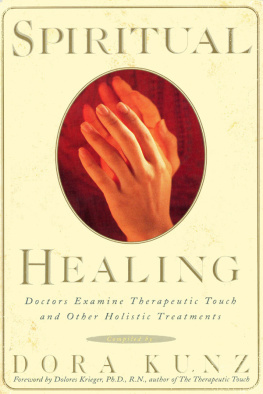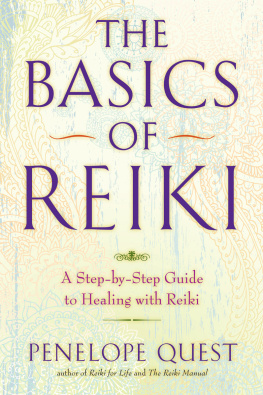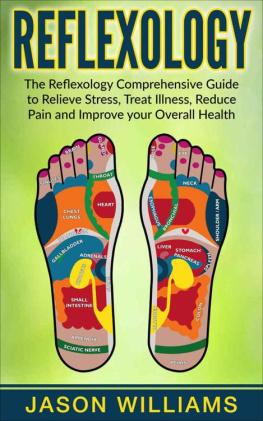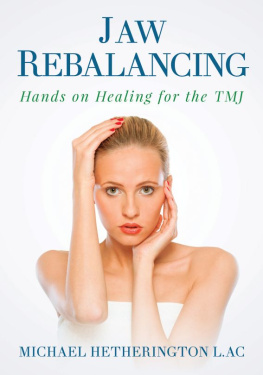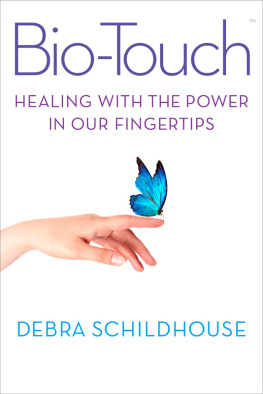Janet Macrae - Therapeutic Touch
Here you can read online Janet Macrae - Therapeutic Touch full text of the book (entire story) in english for free. Download pdf and epub, get meaning, cover and reviews about this ebook. year: 2010, publisher: Knopf Doubleday Publishing Group, genre: Religion. Description of the work, (preface) as well as reviews are available. Best literature library LitArk.com created for fans of good reading and offers a wide selection of genres:
Romance novel
Science fiction
Adventure
Detective
Science
History
Home and family
Prose
Art
Politics
Computer
Non-fiction
Religion
Business
Children
Humor
Choose a favorite category and find really read worthwhile books. Enjoy immersion in the world of imagination, feel the emotions of the characters or learn something new for yourself, make an fascinating discovery.

- Book:Therapeutic Touch
- Author:
- Publisher:Knopf Doubleday Publishing Group
- Genre:
- Year:2010
- Rating:3 / 5
- Favourites:Add to favourites
- Your mark:
- 60
- 1
- 2
- 3
- 4
- 5
Therapeutic Touch: summary, description and annotation
We offer to read an annotation, description, summary or preface (depends on what the author of the book "Therapeutic Touch" wrote himself). If you haven't found the necessary information about the book — write in the comments, we will try to find it.
Therapeutic Touch — read online for free the complete book (whole text) full work
Below is the text of the book, divided by pages. System saving the place of the last page read, allows you to conveniently read the book "Therapeutic Touch" online for free, without having to search again every time where you left off. Put a bookmark, and you can go to the page where you finished reading at any time.
Font size:
Interval:
Bookmark:
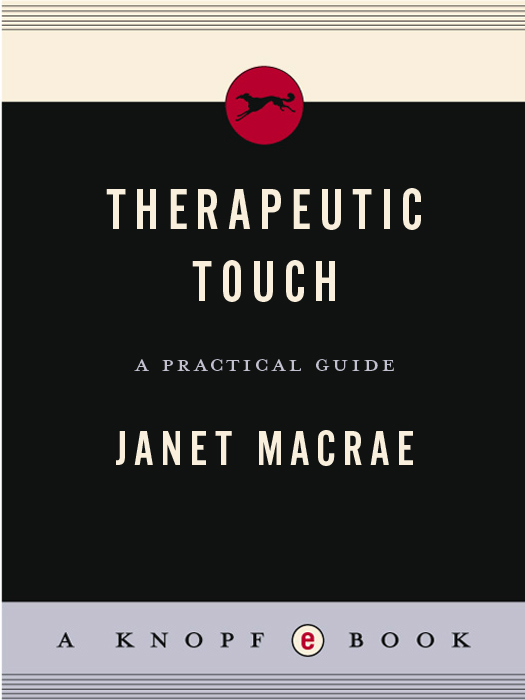
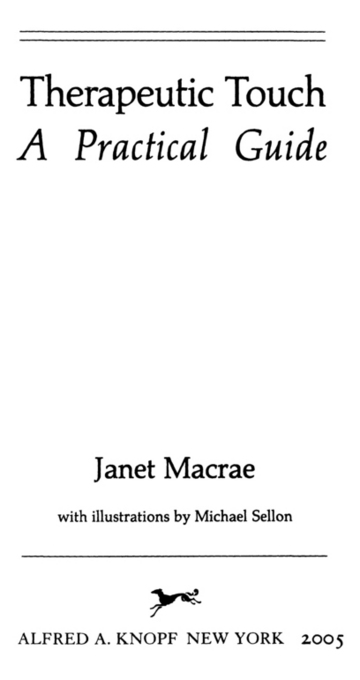
THIS IS A BORZOI BOOK
PUBLISHED BY ALFRED A. KNOPF, INC .
Copyright 1987 by Janet A. Macrae
Illustrations copyright 1987 by Michael Sellon
All rights reserved under International and Pan-American Copyright Conventions. Published in the United States by Alfred A. Knopf, Inc., New York, and simultaneously in Canada by Random House of Canada Limited, Toronto. Distributed by Random House, Inc., New York.
Library of Congress Cataloging-in-Publication Data
Macrae, Janet. Therapeutic touch.
I. TouchTherapeutic use. 2. Vitality. 3. Force and energy. I. Title.
RZ 999. M 34 1988 615.5 87-45444
eISBN: 978-0-307-77242-8
NOTE TO READERS .
The technique of Therapeutic Touch described in this book is not intended as a substitute for medical treatment or surgery but as a complement to them.
Published February 2, 1988
Reprinted Eleven Times
Thirteenth Printing, July 2005
v3.1
This book is dedicated to
Dora Kunz and Dee Krieger,
and to all my friends and colleagues
with whom I have been privileged
to share this healing journey.
This book is a guide for the practice of Therapeutic Touch, which is a way of acting as an instrument of healing. The term healing, in this context, refers to the integrating tendency within the individual as a whole: body, mind, and creative spirit, and so the focus is on the process of balancing the energies of the total person rather than on the treatment of specific physical diseases. Since the ability to assist the healing process through Therapeutic Touch is thought to be present in everyone, this book is addressed not only to health professionals but to anyone who would like to learn.
As I will discuss later, the main requirements on the part of the student are good health, compassion, and a willingness to discipline oneself and learn the basic aspects of the method. A sense of adventure is also helpful, because the practice of Therapeutic Touch involves opening oneself to a new dimension or mode of perceiving. Most of our knowledge of the world comes through our physical senses or their extensions by way of instruments such as microscopes and telescopes. We describe objects and events by the way they look, feel, sound, smell, and taste. The practice of Therapeutic Touch, however, is based on the concept of a subtle, non-physical energy, which sustains all living organisms. This energy is not an abstraction but a vitalizing, universal force, which is always present and available. The practice of Therapeutic Touch represents a conscious effort to draw upon this universal life energy and direct its flow for healing. I have tried to describe, as accurately as possible, how to attune to this subtle energy, identify various ways in which it can become disordered by disease, and help re-establish a normal flow. Since there are no adjectives in our language that directly pertain to subtle energy qualities, my descriptions should not be taken literally but should be regarded as analogies or metaphors. Thus when I say that a certain type of imbalance feels hot, I am not referring to the sensation of physical heat, which we feel with the receptors in our skin. Rather, I am trying to describe an energy quality that has a feeling-tone resembling heat. As these subtle cues are perceived subjectively and thus can be described in slightly different ways, I often use several adjectivesat the risk of appearing redundantto help clarify my meaning.
I have outlined the method; but to avoid cluttering it with details, I have saved a discussion of various issues and problems (all of which have been raised by students) for the chapter that follows it. And finally, since the practice of Therapeutic Touch involves making oneself an instrument for the healing force, the last chapter is concerned with the transformation of the practitioner. One becomes, so to speak, what one has learned.
Since English does not have one pronoun for both sexes, I have used he and she interchangeably instead of the cumbersome he/she construction, for I wanted the words to flow in a dance that would reflect, in some measure, the beauty of this method of healing. I have used the word patient instead of healee or client simply because this is the term with which I am most familiar and comfortable as a nurse with a traditional education. I have avoided using the word healer in reference to the individual who is practicing Therapeutic Touch because I feel this term can be very misleading. There is no simple answer to the question Who is doing the healing? Is it the innate healing potential within all living things? Is it the life energy, a universal force that has order as its basis? Is it the practitioner, who serves as a conduit or an instrument? Or is it a combination of all three at a crucial moment? I have tried to explain what I understand about assisting the healing process through Therapeutic Touch, but essentially it remains a mystery, as does life itself.
I have focused on the use of Therapeutic Touch with human beings because most of my experience with the method lies in this area. This is not to imply, however, that the practice is designed for, or should be restricted to, only one form of life. Therapeutic Touch is based upon the view that the world is a dynamic, interconnected whole. All living organisms share the same life energy, and thus the principles of this method have universal application.


An Introduction to
Therapeutic Touch
Nature alone cures. And what nursing has to do is to put the patient in the best condition for nature to act upon him.
FLORENCE NIGHTINGALE , Notes on Nursing
Therapeutic Touch has been derived from the ancient practice of the laying-on of hands. It is based on the fundamental assumption that there is a universal life energy that sustains all living organisms. Although the idea of a subtle vital energy is only just beginning to be accepted in Western medicine, it has long been a feature of Eastern therapeutic systems. In India, for example, the energy is called prana and is associated with the breath. From ancient times, breathing exercises known as pranayama (literally translated as the regulation of prana) were designed to enhance well-being through a balancing of the life-energy flow.
Currently, the concept of a universal life energy is being linked to field theory and seen as exhibiting the characteristics of a force field. we make the assumption that the vital energy is also a field force, that is, that it permeates space, becoming more concentrated within and around living organisms. Thus all living things without exception share in a generalized life-energy field, in the same way that all physical objects in space are subject to gravity.
In a state of health, the life energy flows freely in, through, and out of the organism in a balanced manner, nourishing all the organs of the body. In disease, the flow of the energy is obstructed, disordered, and/or depleted. Therapeutic Touch practitioners, having learned to attune to the universal field through a conscious intent, direct the life energy into the patients to enhance their vitality. The practitioners also help the patients assimilate the energy by releasing congestion and balancing areas where the flow has become disordered. Drawing upon the universal field, the practitioners do not become drained of their own energy but, on the contrary, are continually replenished. Since the localized field of the patient penetrates and extends beyond the body, actual physical contact is not necessary for Therapeutic Touch. In fact, for reasons that will be discussed later, most practitioners prefer to work a few inches from the surface of the patients skin.
Font size:
Interval:
Bookmark:
Similar books «Therapeutic Touch»
Look at similar books to Therapeutic Touch. We have selected literature similar in name and meaning in the hope of providing readers with more options to find new, interesting, not yet read works.
Discussion, reviews of the book Therapeutic Touch and just readers' own opinions. Leave your comments, write what you think about the work, its meaning or the main characters. Specify what exactly you liked and what you didn't like, and why you think so.

